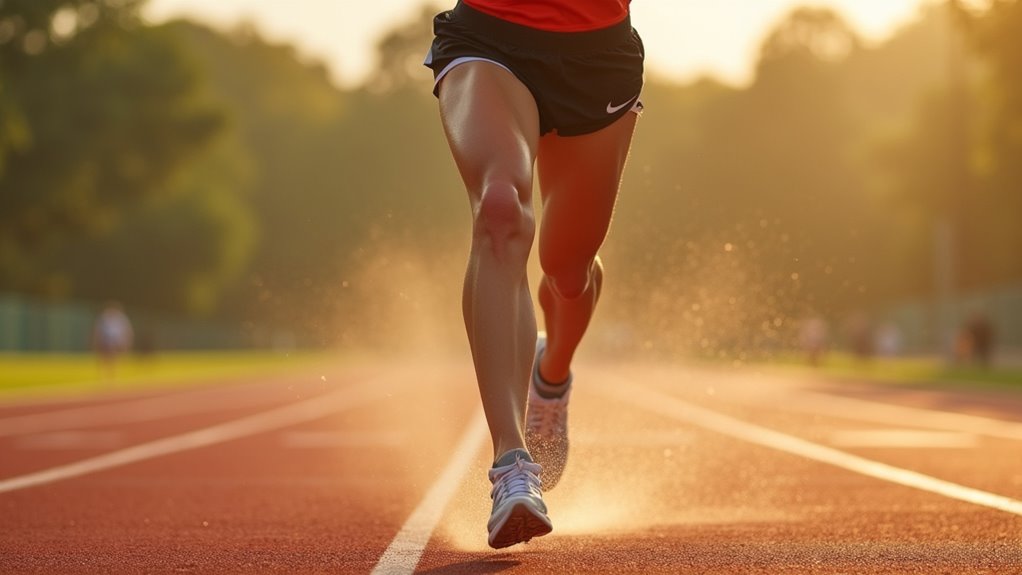Sports participation improves your physical health through multiple physiological adaptations. You’ll experience improved cardiovascular fitness as your heart muscle strengthens and blood circulation increases. Your muscle strength and endurance develop while your metabolic rate rises, supporting weight management. Sports activities also refine your balance, coordination, and proprioception through complex movement patterns. Regular participation optimizes joint health and movement mechanics, with extensive benefits extending far beyond these initial adaptations.
Key Takeaways
- Regular sports participation strengthens the heart muscle and improves blood circulation, reducing the risk of cardiovascular disease.
- Sports build muscle strength and endurance, increasing power output and improving overall physical performance capabilities.
- Physical activity through sports helps manage weight by burning calories and boosting metabolic rate during and after exercise.
- Sports enhance balance, coordination, and body awareness through complex movement patterns and improved neural pathways.
- Regular participation in sports promotes joint health and proper movement mechanics, reducing injury risk and supporting long-term mobility.
Cardiovascular Benefits and Heart Health

Regular participation in sports activities greatly boosts cardiovascular fitness by strengthening the heart muscle and improving blood circulation throughout the body. When you engage in aerobic exercise through sports, you’ll increase your heart rate, which forces your heart to pump more efficiently. This improved heart efficiency leads to better blood circulation and enhanced cardiovascular endurance over time.
Research shows that consistent sports participation helps lower your cholesterol levels and reduces your risk of heart disease. You’ll notice improvements in your fitness levels as your heart becomes stronger and more capable of handling physical stress. The cardiovascular benefits extend beyond exercise sessions, as your resting heart rate typically decreases, indicating a more efficient circulatory system. These adaptations help your body deliver oxygen and nutrients more effectively to working muscles and essential organs.
Muscle Strength and Endurance Development

While cardiovascular exercise strengthens your heart, sports activities also trigger significant adaptations in your skeletal muscle tissue. Regular participation in strength training and endurance activities stimulates myofibrillar protein synthesis, leading to improved muscular capabilities.
Your body responds to athletic demands through multiple physiological mechanisms:
- Increased cross-sectional area of muscle fibers, resulting in greater force production capacity
- Improved recruitment of motor units, enhancing neuromuscular efficiency and coordination
- Raised mitochondrial density within muscle cells, augmenting aerobic energy production
- Amplified glycogen storage capacity, supporting prolonged physical performance
These adaptations translate into practical benefits as you’ll experience improved power output, reduced fatigue during extended activities, and increased ability to perform daily tasks. Research indicates these changes occur progressively through consistent sports participation, with measurable improvements typically observed within 4-8 weeks.
Weight Management and Metabolism

Sports participation serves as a powerful mechanism for weight management through its direct influence on both basal metabolic rate (BMR) and daily energy expenditure. When you engage in regular athletic activities, you’ll experience increased caloric expenditure during both exercise and post-exercise periods, known as excess post-exercise oxygen consumption (EPOC).
Your body’s metabolic rate increases considerably during sports activities, burning anywhere from 400 to 1000 calories per hour depending on the intensity and type of sport. The metabolic benefits extend beyond the activity itself, as regular sports participation leads to increased muscle mass, which raises your BMR even during rest periods. You’ll also develop improved insulin sensitivity and more efficient fat oxidation, contributing to better long-term weight management and metabolic health.
Balance and Coordination Enhancement
Beyond metabolic adaptations, athletic activities create profound neurophysiological changes in your vestibular and proprioceptive systems. Regular sports participation improves your motor skills through repeated exposure to complex movement patterns and dynamic environments.
- Your cerebellum adapts to sport specific demands, improving spatial awareness and postural control
- Neural pathways strengthen through repetitive athletic performance, leading to improved hand-eye coordination
- Your body’s mechanoreceptors become more sensitive, allowing faster responses to positional changes
- Neuromuscular junction efficiency increases, resulting in smoother movement execution
These adaptations don’t just improve your athletic performance; they’re vital for daily activities. Research shows that individuals who regularly engage in sports demonstrate superior balance metrics and reduced fall risk compared to sedentary populations. The improved coordination you’ll develop transfers to numerous aspects of physical function.
Bone Density and Joint Health
Through consistent participation in athletic activities, your skeletal system undergoes significant osteogenic adaptations that improve both bone mineral density and structural integrity. The mechanical loading from sports stimulates osteoblast activity, leading to improved calcium deposition and stronger bone matrix formation.
You’ll experience increased joint stability as your connective tissues adapt to repetitive movement patterns. Sports that involve weight-bearing exercises are particularly effective for osteoporosis prevention, as they trigger bone remodeling responses that strengthen your skeletal framework. Research indicates that athletes typically maintain higher bone density scores compared to sedentary individuals, and you’ll develop stronger ligaments and tendons that protect your joints from injury. These adaptations become essential as you grow older, helping you maintain mobility and reducing the risk of age-related bone deterioration.
Flexibility and Range of Motion
When participating in regular athletic activities, you’ll experience significant improvements in your musculotendinous flexibility and joint mobility. Through consistent dynamic stretching and mobility exercises, your body adapts to the demands of your chosen sport, enhancing your overall physical performance and reducing injury risk.
- Regular engagement in sports promotes increased muscle length and extensibility, allowing for more efficient movement patterns during both athletic and daily activities
- Dynamic stretching during warm ups maximizes your neuromuscular coordination and prepares your joints for sport-specific movements
- Sports that require diverse movement patterns contribute to improved proprioception and kinesthetic awareness
- Mobility exercises incorporated in sports training help maintain peak joint function while preventing movement compensations that could lead to biomechanical inefficiencies
Disease Prevention and Immune System
Regular physical activity associated with sports participation greatly improves your immune system function and reduces susceptibility to different diseases. When you exercise through sports, you’ll experience an immune enhancement as your body increases the production of antibodies and white blood cells, enhancing your defense against pathogens.
Research shows that engaging in sports for at least 150 minutes per week can lower your risk of chronic illness, including type 2 diabetes, cardiovascular disease, and certain types of cancer. Your body’s inflammatory responses become more regulated, while your metabolism improves considerably. Furthermore, sports participation strengthens your respiratory system, reducing your vulnerability to respiratory infections. The increased blood circulation during physical activity helps flush bacteria from your lungs and airways, further supporting your body’s natural defense mechanisms.
Recovery and Injury Prevention
Building upon the immune system benefits, athletic participation also develops your body’s capacity for recovery and resistance to injury. Through consistent training, you’ll cultivate improved biomechanical awareness and improved tissue resilience, leading to better injury prevention outcomes.
Research demonstrates that sports participation teaches you essential rehabilitation techniques and injury awareness through:
Active sports participation equips athletes with vital knowledge of injury prevention and recovery methods through hands-on experience and practical training.
- Proper warm up and cool down protocols that optimize muscle recovery and reduce post-exercise inflammation
- Development of proprioception and neuromuscular control, decreasing the likelihood of acute injuries
- Acquisition of correct movement patterns that minimize mechanical stress on joints and connective tissues
- Greater understanding of your body’s warning signals, enabling early intervention before major injuries occur
This preventive approach considerably reduces recovery time when injuries do occur and promotes long-term musculoskeletal health.
Frequently Asked Questions
How Long Should I Rest Between Different Sports Activities?
You’ll need to follow specific resting guidelines based on your activity intensity and type. For moderate exercises, allow 24-48 hours between sessions, while intense activities require 48-72 hours for proper activity recovery. If you’re cross-training different muscle groups, you can exercise daily. However, you should monitor your body’s signals and adjust rest periods accordingly. Professional athletes often follow periodization schedules to optimize their recovery between sports activities.
Can Playing Sports Help Improve My Sleep Quality?
Regular sports participation can greatly improve your sleep quality. Physical exertion during athletic activities increases your body’s need for recovery, naturally regulating sleep patterns. Research shows that you’ll experience improved slow-wave sleep, which is essential for physical restoration. You’ll also benefit from reduced sleep latency, meaning you’ll fall asleep faster. However, avoid intense exercise within 2-3 hours before bedtime, as this might disrupt your sleep cycle.
At What Age Should Children Start Participating in Organized Sports?
You’ll find that developmental recommendations for organized sports vary based on individual development and sport type. Research suggests children can begin with basic athletic activities around the age of 6-7, when they’ve developed fundamental motor skills. However, early participation in structured programs can start as young as the age of 3-4 with modified activities like tumbling or swimming. The key is ensuring the activities match your child’s physical capabilities, emotional readiness, and attention span.
How Do Team Sports Affect Mental Health Compared to Individual Sports?
When you participate in team sports, you’ll experience unique psychological benefits through team dynamics, such as improved social support and shared accountability. Research shows that team environments foster stronger emotional resilience and reduced anxiety compared to individual sports. However, individual sports can offer focused personal growth opportunities, allowing you to develop self-reliance and internal motivation. Studies indicate both formats support mental health differently, with team sports generally showing higher rates of psychological well-being.
What Sports Are Best for People With Existing Medical Conditions?
You’ll find adaptive sports particularly beneficial if you have existing medical conditions, as they’re specifically designed to accommodate diverse health challenges. Under proper medical supervision, you can investigate low-impact activities like swimming for joint conditions, yoga for respiratory issues, or seated volleyball for mobility limitations. It’s essential that you consult your healthcare provider before starting any sport, as they’ll help tailor activities to your specific medical needs and limitations.






